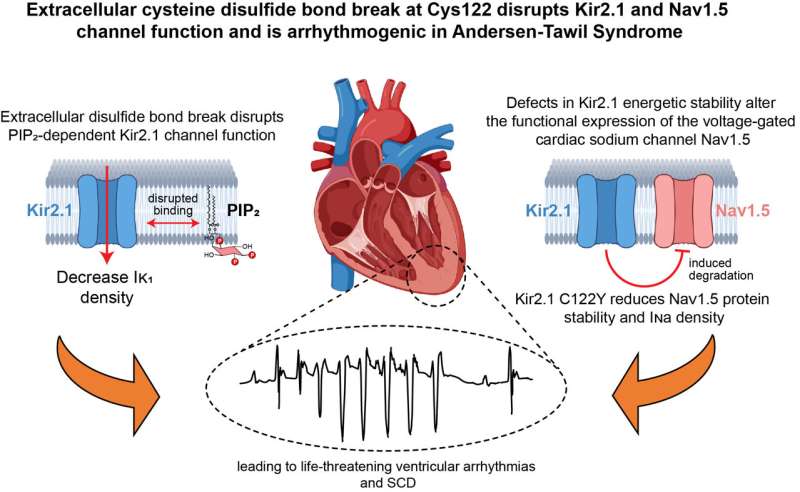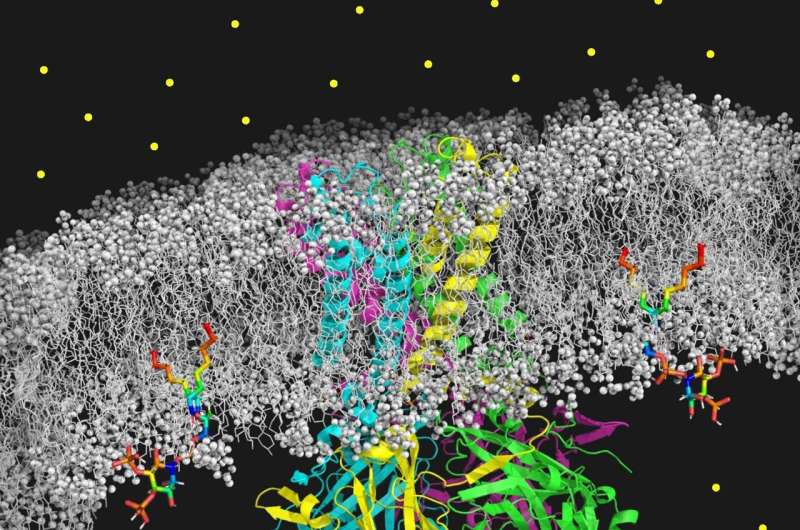This article has been reviewed according to Science X's editorial process and policies. Editors have highlighted the following attributes while ensuring the content's credibility:
fact-checked
peer-reviewed publication
proofread
New mechanism discovered for life-threatening arrhythmias in Andersen-Tawil syndrome

A team at the Centro Nacional de Investigaciones Cardiovasculares (CNIC) has made a breakthrough discovery in the understanding of cardiac arrhythmias by unraveling the complexities of Andersen-Tawil syndrome (ATS), an extremely rare inherited cardiac disorder.
Led by Dr. José Jalife, head of the CNIC Cardiac Arrhythmia Group, the study demonstrates that a specific genetic mutation (C122Y) in the Kir2.1 potassium channel alters the function not only of Kir2.1 but also of the main cardiac sodium channel NaV1.5, thus establishing a direct link with the life-threatening arrhythmias associated with ATS1.
The study, published in the journal Circulation Research, reveals that the C122Y mutation in Kir2.1 has a dual effect: it causes a reorganization of the Kir2.1 channel that destabilizes its binding to the phospholipid PIP2, a key lipid-signaling component of the cell membrane, and also disrupts the expression of the protein that forms the NaV1.5 channel, impairing its function. The interaction between these two channels is vital for a stable heart rate.
Cardiac arrhythmia affects an estimated one in three people at some point in their life, although ATS is a very rare disease that affects fewer than one in a million people. ATS is characterized by a triad of symptoms including periodic paralysis, cardiac arrhythmias, and distinctive facial features. ATS1 is caused by mutations in KCNJ2—the gene encoding Kir2.1—that are inherited in an autosomal dominant manner.
In the study, the researchers created a mouse model that replicates the major cardiac electrical irregularities observed in patients with ATS1. This model surprisingly revealed that the mutation not only affects Kir2.1, but also interferes with the stability and expression of the NaV1.5 channel in the heart, impairing its function.
Dr. Jalife underscored the importance of the interaction between these channels for cardiac health, explaining that any alteration that disturbs the function of one or both channels can trigger life-threatening arrhythmias.
Speaking about the new study, first author Dr. Francisco Cruz said, "The discovery that a mutation considered 'monogenic' disrupts not only the ion channel directly affected by the mutation, but also a complementary channel is important. Both channels are essential for cardiac excitability and electrical conduction, and the new discovery provides insight into the mechanisms underlying cardiac arrhythmias associated not only with ATS1, but also with more frequent cardiac diseases."

Dr. Cruz added that the results "support the hypothesis that molecular mechanisms vary according to the specific mutation, opening the door to personalized pharmacological treatments and clinical management for patients."
This advance, the researchers conclude, represents a milestone in the approach to cardiac arrhythmias, offering new understanding with potential clinical impact. Improving knowledge about the function of the Kir2.1 channel represents a key step towards innovative and safe approaches to preventing sudden death in several cardiac diseases, potentially benefiting millions of people worldwide.
The results of the new study support the hypothesis that the molecular mechanisms that increase susceptibility to arrhythmias and sudden cardiac death in ATS1 depend on the specific mutation, so that pharmacological treatment and clinical management should be tailored to each individual patient.
More information: Francisco M. Cruz et al, Extracellular Kir2.1 C122Y Mutant Upsets Kir2.1-PIP2 Bonds and Is Arrhythmogenic in Andersen-Tawil Syndrome, Circulation Research (2024). DOI: 10.1161/CIRCRESAHA.123.323895

















